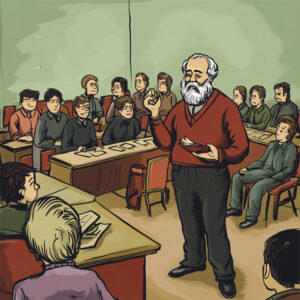 Republicans have long raged against what they call the “death tax” and while they have not eliminated the estate tax, they succeeded in changing it. In 2017 the estate tax applied only to individuals with total assets exceeding $5.49 million (double for a married couple). After the Republican tax bill passed, the number was increases to $11.8 million (double for a married couple). For 2025, it is $13.9 million. Given the exceptional wealth inequality in the United States, the change impacted very few but was advantageous to the wealthy.
Republicans have long raged against what they call the “death tax” and while they have not eliminated the estate tax, they succeeded in changing it. In 2017 the estate tax applied only to individuals with total assets exceeding $5.49 million (double for a married couple). After the Republican tax bill passed, the number was increases to $11.8 million (double for a married couple). For 2025, it is $13.9 million. Given the exceptional wealth inequality in the United States, the change impacted very few but was advantageous to the wealthy.
Trump justified the change based on his claim that it is unfair that people pay taxes twice: once when they earn the money, once more when their assets are inherited. This ignores the fact that those inheriting the assets did not pay the first taxes on it, so they are not paying the tax twice. But if Trump is right, then sales taxes should also be eliminated. You (probably) pay taxes on your income, then you pay sales tax when you make a taxable purchase with that income. But my focus is not on the fairness of taxes but about inheritance.
While inheritance is seen by some as an ancient tradition and a right, there are rational arguments against allowing it at all. Also, as with any tradition and common practice, it would be a fallacy to infer its traditional nature and common practice justify it. After all, people have been commonly doing bad and stupid things for a long time.
A way to argue against inherited wealth is to contend it has negative consequences that make it immoral. Mary Wollstonecraft argued that hereditary wealth is morally wrong because it produces idleness and impedes people from developing their virtues. While complicated to sort out, this does present an empirical claim: one could do a statistical analysis of the impact of hereditary wealth on idleness and virtue.
Interestingly, while conservatives aggressively oppose estate and inheritance taxes, they also use an argument against welfare that would also apply to eliminating inheritance.
A common argument against welfare echoes Wollstonecraft’s argument against hereditary wealth: it makes people idle and prevents them from developing virtues, therefore it should be restricted (or eliminated). Rod Blum, a Republican representative from Iowa, said “Sometimes we need to force people to go to work. There will be no excuses for anyone who can work to sit at home and not work.” Donald Trump, whose fortune was built on inheritance, has said that “The person who is not working at all and has no intention of working at all is making more money and doing better than the person that’s working his and her ass off.” While this might sound like Trump is describing himself, it seems to be his criticism of welfare.
If this criticism of welfare is correct, then it also applies to inheritance. After all, people do not earn their inheritance. As such, if Republicans are sincere in their arguments against welfare, then they must apply the same reasoning to inheritance and oppose it for the same reasons they oppose welfare. Obviously enough, they do not take this position. They advance one set of arguments against welfare and give another set in favor of protecting inheritance and see to it that the two do not meet.
While it is tempting to dismiss this as just another example of Republican inconsistency and hypocrisy, it could be argued that there are relevant differences between inheritance and welfare that break the analogy.
One argument can be built on the fact that inheritance is passed on voluntarily to the recipient, while welfare involves taking tax money from some people who do not want their money used for welfare . A similar argument can be made by pointing out that inheritance usually goes to relatives while state welfare does not. While these are differences, they would not seem to be relevant to the argument that welfare is bad because it makes people lazy. After all, it is getting money that one has not earned that is the problem, not whether it was giving willingly or who it comes from. Unless one wants to make the implausible claim that money given willingly by relatives is special and will not make people lazy.
Another argument can be made arguing that inherited wealth is earned while welfare is not. While this might appeal to some, even a cursory consideration dismantles this view. First, some do earn their welfare by paying for it when they are working. For example, if Sally works for ten years paying taxes and gets fired when her company moves overseas, then she is getting back money from a system she contributed to. Second, if a person did work for their inheritance, it is not actually an inheritance, but something earned. If, for example, someone worked in the family business for pay, then they have earned their pay. But merely working for a business does not entitle a person to own the business after the death of the current owner. So, this sort of argument fails.
If the Republicans are right that welfare is bad because it makes people idle and impedes their virtue, then the same would apply to inheritance, especially large inheritances. As such, if they are opposed to the harm of welfare and must combat them, then they must also oppose the harm of inheritance with an equal or greater intensity. If they don’t, one might think that they simply dislike poor people and their argument against welfare is made in bad faith.
It might be pointed out that if someone opposes inheritance, then they must oppose welfare. One reply is to accept this. If welfare makes people idle and inflicts moral harm, then it would seem right to oppose it. A second reply is to argue that welfare helps people in need and is analogous to family helping family in times of trouble rather than being analogous to inheritance, in which one simply receives wealth regardless of need or merit.
Lest anyone start mass-producing straw men, my concern here is with large inheritances; I obviously have no objection to the sort of inheritance most of us will receive and I certainly have no issue with, for example, someone inheriting grandad’s Hummel collection or grandma’s collection of assault rifles.
In closing, whenever a politician makes the “lazy” argument against welfare, they should be asked if they apply that argument to inherited wealth.

 Reasoning is like chainsaw: useful when used properly, but when used badly it can create a bloody mess. While this analogy can be applied broadly to logic, this essay focuses on the inductive generalization and how it can become a wayward chainsaw under the influence of fear. I’ll begin by looking at our good friend the inductive generalization.
Reasoning is like chainsaw: useful when used properly, but when used badly it can create a bloody mess. While this analogy can be applied broadly to logic, this essay focuses on the inductive generalization and how it can become a wayward chainsaw under the influence of fear. I’ll begin by looking at our good friend the inductive generalization. In July of 2002 the New England Journal of Medicine published a study on arthroscopic surgery.
In July of 2002 the New England Journal of Medicine published a study on arthroscopic surgery. As noted in previous essays, there is a diversity issue in higher education: liberals outnumber conservatives. Given that conservatives have made their view of diversity clear, it is fair to apply their ideology to the issue of the dearth of conservatives in higher education.
As noted in previous essays, there is a diversity issue in higher education: liberals outnumber conservatives. Given that conservatives have made their view of diversity clear, it is fair to apply their ideology to the issue of the dearth of conservatives in higher education. As noted in the previous essay, perhaps conservatives have good reasons to not want to be professors or professors have good reasons not to be conservatives. In this essay, I will offer some possible DEI solutions to the dearth of conservatives in higher education.
As noted in the previous essay, perhaps conservatives have good reasons to not want to be professors or professors have good reasons not to be conservatives. In this essay, I will offer some possible DEI solutions to the dearth of conservatives in higher education. While the culture warriors claim Marxism dominates higher education, a more realistic concern is that
While the culture warriors claim Marxism dominates higher education, a more realistic concern is that  In the eternal culture war, folks on the right claim that
In the eternal culture war, folks on the right claim that  The intense politicalization of ecological issues makes it difficult to have a rational discussion of environmental regulation. When the left wants regulation, the right can claim they want to destroy jobs because of a deranged preference for tiny fish over humans. When the right opposes regulation, they can be presented as willing to destroy the environment because they value profits over other people and the planet. This conflict leads to the seesaw of regulations as each party takes and loses power. While there is no single solution to this problem, a rational approach would be to try to develop solutions that benefit corporations and the inhabitants of the ecosystem, such as us humans. As an example, I will use the seabirds.
The intense politicalization of ecological issues makes it difficult to have a rational discussion of environmental regulation. When the left wants regulation, the right can claim they want to destroy jobs because of a deranged preference for tiny fish over humans. When the right opposes regulation, they can be presented as willing to destroy the environment because they value profits over other people and the planet. This conflict leads to the seesaw of regulations as each party takes and loses power. While there is no single solution to this problem, a rational approach would be to try to develop solutions that benefit corporations and the inhabitants of the ecosystem, such as us humans. As an example, I will use the seabirds.
 A few years ago, at my annual checkup, my systolic blood pressure was 145. My doctor was concerned and asked me to monitor my blood pressure. I already owned an automatic blood pressure checker and started taking regular readings, finding that my blood pressure was consistently good (110-130) at home. This inspired an investigation.
A few years ago, at my annual checkup, my systolic blood pressure was 145. My doctor was concerned and asked me to monitor my blood pressure. I already owned an automatic blood pressure checker and started taking regular readings, finding that my blood pressure was consistently good (110-130) at home. This inspired an investigation.